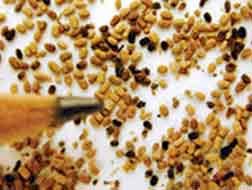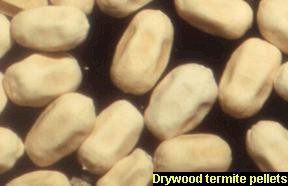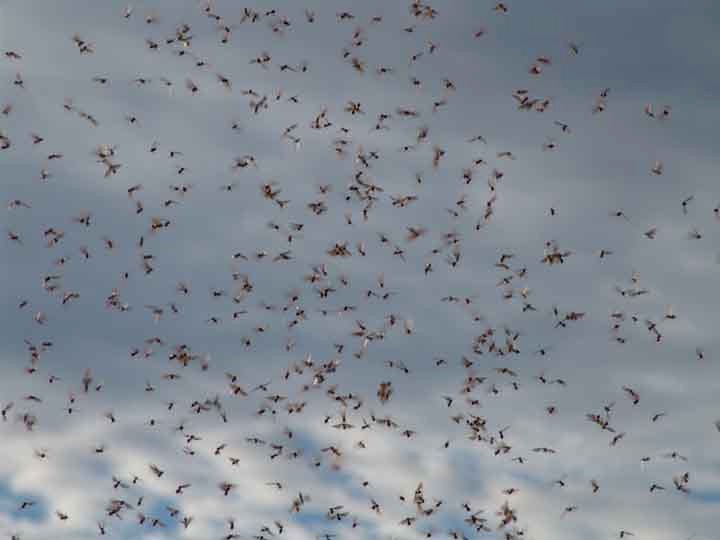Drywood Termites
Detecting and Controlling Termites is a Job For The Professional
...


A thorough inspection by a California State Licensed termite control specialist is the first and most important step in protecting your property. Only "Experienced" eyes can locate the specific areas in your structure where termite attack is likely to occur. While a homeowner may initially detect the presence of termites when they swarm or if fecal pellets or "mud tubes" are discovered, inspecting for drywood termites and determining the extent of an infestation require experience. If a termite infestation is found, the Exterminetics Inspector will design a treatment plan for your property that will control any current infestation and offer preventative measures in and around the structure to inhibit further termite entry.
In California we deal with two predominant termites, the Western Subterranean Termites and the Drywood Termite.
The Inspection Process – Exterminetics uses only California State Licensed Inspectors for the inspection of your home. Inspectors are courteous, informative, on time and committed to excellent customer service. We will conduct a complete and thorough inspection of your home and property from top to bottom. Once the inspection is completed your inspector will provide you with a detailed and customized termite eradication program. Your inspector will review with you any findings and recommendations that will be included in an official state report. Pricing options, service availability dates and times will be provided on the spot.
Treatment Options: Exterminetics offers a variety of treatment options including: Fumigation, ThermaPure Heat, Local Treatments, Preventative Treatments, extended warranties & Control Policies.
We also offer alternative and non-chemical treatment that your State Certified Inspector can discuss with you during your inspection.
Fumigation – Full structure treatment including all attached structures, including decks, patios and garages. This process usually takes three days and two nights to complete and comes with a full structure warranty. If fumigation is selected your State Certified Inspector will share with you all necessary information regarding the fumigation process so that you and your family are adequately prepared.
Fumigants (sulfuryl fluoride) treat all infestations simultaneously, and have high levels of efficacy, often 100% if correctly applied. Major issues to consider with the use of fumigants include the difficulty of installing tarpaulins, the difficulty in determining the proper dosage, the need to protectively bag food items, and the lack of residual control. Residual control means long-term protection from drywood termite attack, often for several years or more. (Generally, only chemicals added to or onto wood provide residual control.) Vacating structures 1 to 2 days for treatment and ventilation, and the possible damage to roofs caused by dragging tarpaulins or walking are additional considerations with fumigant use.
HeatPro Thermal Pest Eradication by – The heat treatment usually takes from 5 to 8 hours. While some preparation is required in the treatment zones, most customers love this option as no chemicals are used and no overnight move-outs are required. Not all homes qualify for the HeatPro option due to type of construction. Your State Certified Inspector will provide you with all necessary information regarding the heat process.
HeatPro is a nonchemical option for whole-structure treatments. The treatment process involves heating wood in the structure to at least 124°F and holding this temperature for at least 30 minutes. The benefit of heat treatment is the ability to treat the entire structure without the use of chemicals and the relatively short period of time the structure must be vacated (hours instead of days, as with the use of fumigants). An additional advantage is that portions of large structures can be treated separately, which is very useful in apartments and condominiums.
Local Treatments –
-
For Drywood Termites and wood boring insects – When you suspect termite infestation you need someone experienced in scrutinizing homes for the most minute signs of infestation. We are educated in the ways of termites and the means of eradicating them. We offer local direct wood treatments, including attic dusting and foaming injection. Exterminetics uses a variety of traditional products as well as Borates and products that are of natural origin and biodegradable.
Localized or Spot Treatments
There are many localized/spot treatment methods available that include both chemical and nonchemical options. The chemical options include liquid organophosphates and pyrethroids, borate and desiccant (silica gel) dusts, and liquid nitrogen. For the liquid and dust insecticides to be effective, they must be touched or ingested by termites.Efficacy information is lacking for most chemical spot treatments for drywood termites. For all spot treatments of chemicals it is critical that all infestations in a structure are detected so that they all receive treatment.
ThermaPure Heat can also be used as a nonchemical options for drywood termite control with spot or localized application. The advantages discussed for heat as a whole-structure treatment also apply to spot treatments.
-
For Subterranean Termites – We offer localized and whole house soil treatments using the next generation of products that that are 100% effective against termites. We offer long term warranties that provide full house protection for your home. If your State Certified Inspector determines that termites have invaded your home, they will recommend a treatment plan that will stop them and prevent them from returning.
TERMITES
Termites are small, white, tan, or black insects that can cause severe destruction to wooden structures. Termites belong to the insect order Isoptera, an ancient insect group that dates back more than 100 million years. The Latin name Isoptera means "equal wing" and refers to the fact that the front set of wings on a reproductive termite is similar in size and shape to the hind set.Although many people think termites have only negative impacts, in nature they make many positive contributions to the world's ecosystems. Their greatest contribution is the role they play in recycling wood and plant material. Their tunneling efforts also help to ensure that soils are porous, contain nutrients, and are healthy enough to support plant growth. Termites are very important in the Sahara Desert where their activity helps to reclaim soils damaged by drying heat and wind and the overgrazing by livestock.
Termites become a problem when they consume structural lumber. Each year thousands of housing units in the United States require treatment for the control of termites. Termites may also damage utility poles and other wooden structures. Termite pests in California include drywood, dampwood, and subterranean species. These pests cause serious damage to wooden structures and posts and may also attack stored food, books, and household furniture.
IDENTIFICATION
Termites are social and can form large nests or colonies, consisting of very different looking individuals (castes). Physically the largest individual is the queen. Her function is to lay eggs, sometimes thousands in a single day. A king is always by her side. Other individuals have large heads with powerful jaws, or a bulblike head that squirts liquid. These individuals are called soldiers. But the largest group of termites in a colony is the workers. They toil long hours tending the queen, building the nest, or gathering food. While other species of social insects have workers, termites are unique among insects in that workers can be male or female. Surprisingly, termites can be long-lived: queens and kings can live for decades while individual workers can survive for several years.Signs of termite infestation include swarming of winged forms in fall and spring and evidence of tunneling in wood. Blistering of wooden structural members is another indication of an infestation; wood in damaged areas is typically thin and easily punctured with a knife or screwdriver.
Termites can't distinguish between the wood in your home and the wood in the forest. It's important to remember that just because you've never seen termites or termite swarms in your home, that doesn't necessarily mean your home is termite-free. It can take several years before a termite colony produces swarmers. And since swarming normally occurs once or twice a year and lasts a very short period of time, you may not see them.
Prevention –Your detailed Exterminetics inspection will include necessary information for the prevention of termites, including solutions for conducive conditions such as faulty grades, moisture issues, plumbing leaks, and earth to wood contact.
Warranties & Control Policies – Exterminetics offers some of the best Warranties and Annual Control Policies in the industry. The Inspector will cover the details of these programs at the conclusion of your inspection.
Termite Facts:
- Termite mounds are the tallest non-human constructions on earth.
- You can start your own termite farm by purchasing a termite colony from insects.co.uk
- A South American termite nest was discovered that was composed of more than 3 million termites!
- The combined mass of all termites in the world is more than ten times the mass of all people.
- Termites are also called white ants, but they're not ants, in fact not even closely related to ants.
.
